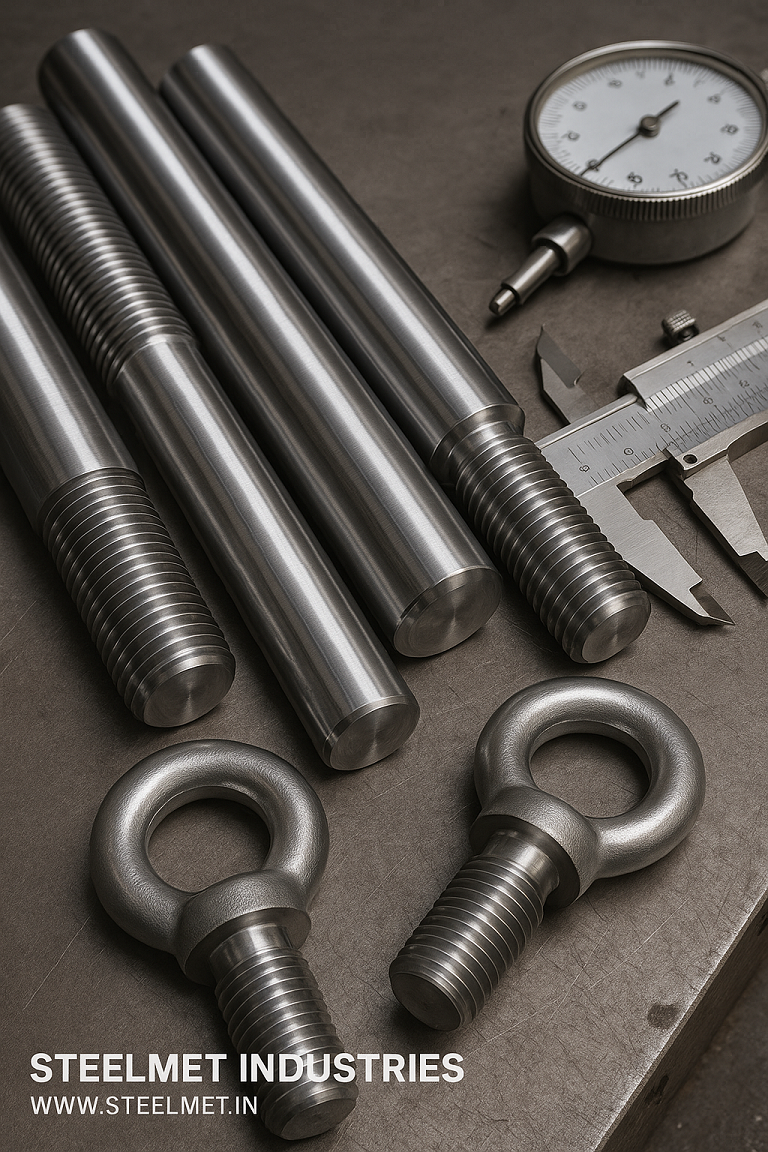Bright Steel Bars for Construction & Structural Applications
Construction and structural components require materials that offer consistent strength, dimensional reliability and safe load-bearing performance. Bright steel bars are used in precision structural parts, lifting hardware, anchoring elements, fabricated assemblies and heavy-duty fixtures where tolerance accuracy and repeatable machining are essential. Their uniform surface finish, controlled chemistry and predictable heat-treatment response make them suitable for both static and dynamic load conditions across building, civil and infrastructure projects.

Bright bars staged for machining into anchor rods, lifting eyes, connectors and precision structural fittings.
Primary Applications
- Anchor rods, anchor bolts and foundation fastening hardware
- Lifting hooks, clevises, shackles and lifting eyes
- Structural dowels, locating pins and reinforcement connectors
- Threaded rods and structural tie rods
- Precision structural components used in industrial buildings
- Machined plates, guides, sleeves and construction jigs
Component Groups & Child Pages
Anchor Rods & Foundation Fasteners
Anchor rods resist tensile and shear loading in foundations and heavy structural frames. Bright bars ensure repeatable thread quality, straightness and core strength essential for reliable anchoring.
Lifting Hardware & Safety Components
Lifting eyes, hooks and shackles require toughness and reliable heat-treatment performance. Bright bars offer consistent chemistry and surface quality for safety-critical lifting components.
Structural Connectors & Precision Fitments
Connectors, dowels and structural pins demand accurate diameters and clean surfaces to maintain alignment and engineered clearances in assemblies.
Why bright bars are preferred for construction & structural applications
- Improved dimensional accuracy ensures correct thread engagement and straightness in anchor rods.
- Better machinability improves production of large threaded or stepped structural parts.
- Uniform microstructure helps achieve consistent heat-treatment strength across batches.
- Smooth surface finish reduces crack initiation sites in cyclic-loaded structural parts.
- Clean edges and chamfers improve fitment in fabricated assemblies and jigs.
Real-world use case
A construction hardware manufacturer adopted EN8D bright bars for anchor bolts and tie rods across large industrial projects. The improved surface condition and controlled diameter led to more consistent threading, fewer rejections and better performance in torque and pull-out tests.
Quick decision pointers
- For threaded anchor rods: EN8D / C40 and C45 offer a good balance of strength and machinability.
- For heavy lifting components: EN19 or EN24 provide higher toughness and fatigue resistance.
- For structural dowels and alignment pins: C45 bright bars maintain straightness and fit accuracy.
- For wear-loaded hardware: EN24 or EN31 depending on required surface hardness.
Failure-prevention and quality notes
- Define thread tolerances and surface condition for anchor bolts to ensure correct torque application.
- Specify core hardness for lifting components to prevent brittle fractures under shock load.
- Use controlled heat-treatment cycles for EN19/EN24 in safety-critical applications.
- Inspect for straightness in dowels and alignment pins to avoid misalignment in structural frames.
- Include corrosion protection requirements (hot-dip galvanizing, phosphate, paint) for outdoor use.
Standards & Equivalents (Table 1)
| IS | BS970 | AISI / SAE | DIN / EN | JIS | GOST | GB |
|---|---|---|---|---|---|---|
| C45 | EN8 | 1045 | C45E / 1.1191 | S45C | 45 | 45# |
| EN8D / C40 | 080M40 | 1040 | C40 / 1.0511 | S40C | 40 | 40# |
| EN19 | 708M40 | 4140 | 42CrMo4 / 1.7225 | SCM440 | 40Х | 42CrMo |
| EN24 | 817M40 | 4340 | 34CrNiMo6 / 1.6582 | SNCM447 | 40ХН2МА | 34CrNiMo6 |
| EN31 | 070M55 | 52100 | 1.3505 | SUJ2 | ШХ15 | GCr15 |
Grade Selection, Performance & Heat Treatment (Table 2)
| Grade | Typical Application in Construction | Performance Indicators | Typical Heat Treatment Route |
|---|---|---|---|
| C45 / EN8 (1045) | Used for anchor rods, structural pins and moderate-load connectors requiring stable machining and balanced strength. | Machinability: Medium | Hardenability: Low/Medium | Wear Resistance: Moderate | Fatigue Strength: Moderate | Normalize or Q&T; surface treatments optional for corrosion resistance. |
| EN8D / C40 | Suitable for cost-effective threaded rods, dowels and general structural hardware. | Machinability: Medium/High | Hardenability: Low | Wear Resistance: Moderate | Fatigue Strength: Low/Moderate | As-drawn or normalized; heat treatment optional. |
| EN19 (4140 / 42CrMo4) | Recommended for lifting hardware, high-strength threaded parts and torque-loaded connectors. | Machinability: Medium | Hardenability: Good | Wear Resistance: High | Fatigue Strength: High | Quench & Temper; ensure correct tempering for toughness. |
| EN24 (4340 / 34CrNiMo6) | Ideal for severe-duty lifting eyes, shackles and heavy structural fixtures facing repeated shock or impact loads. | Machinability: Medium/Low | Hardenability: Excellent | Wear Resistance: Very High | Fatigue Strength: Very High | Q&T with calibrated temper cycles; optional sub-zero treatment. |
| EN31 / 52100 | Used for wear-intensive hardware such as rollers, sleeves, bush-contact zones or surface-critical structural elements. | Machinability: Low | Hardenability: Excellent | Wear Resistance: Very High | Fatigue Strength: Very High | Through-hardened and tempered; optimized for contact fatigue resistance. |
Inspection & manufacturing checklist
- Check thread pitch and OD tolerance for anchor bolts to avoid torque mismatch.
- Confirm hardness for lifting hardware following Q&T cycles.
- Ensure straightness and surface finish for dowels and locating pins.
- Specify corrosion protection for components exposed to weather.
- Use NDT for safety-critical lifting and holding components.
Frequently Asked Questions
Which steel grade is best for anchor bolts?
EN8D or C45 are common for standard anchor rods; EN19 is preferred for high-strength foundation or equipment fasteners.
Do lifting eyes and shackles require alloy steel?
Yes. EN19 and EN24 are recommended due to their toughness, reliable heat-treatment response and resistance to brittle fracture under shock.
Is corrosion protection required for construction hardware?
Yes. Outdoor structural components typically require galvanizing, plating or paint coatings depending on exposure.
Contact for Construction & Structural Components
For anchor rods, lifting hardware, structural connectors or precision-machined construction components:
Related:
All bright bar applications —
Heavy Engineering Components —
Industrial Machinery Components

